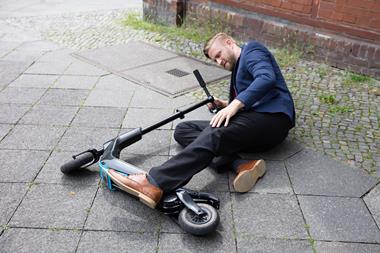The ‘perfect storm’ of vulnerable road user claims falling outside of the OIC portal and a general lack of awareness around the proposed rule changes could create a new ‘target area’ for fraudsters
By Editor Katie Scott
As parliament considers the proposed changes to the UK’s Highway Code – which sets out information, advice, guides and mandatory rules for road users in this country – insurance commentators have begun to unpick the possible unintended consequences of the amended rules and how these could impact the industry.

One key concern flagged by attendees at this week’s Fraud Charter roundtable, hosted virtually by Insurance Times and law firm Carpenters Group, is the potential for fraud targeting vulnerable road users, such as pedestrians and cyclists, as scammers explore “gaming the system” and exploiting “confusion” around who has priority on the roads in certain situations.
For Faye Fishlock, head of defendant insurance services at Carpenters Group, “there are three main changes to consider”, including “the hierarchy of road users, who does the greatest harm and has the greatest responsibility”.
Although these topics are “not a new concept” for those dealing in commercial fleet claims, Fishlock noted, the revised Highway Code aims to clarify “the existing rules on pedestrian priority on pavements [as well as] drivers and riders, but also vulnerable road users – so cyclists, horse riders, etc”.
The fact that the updated rules mainly centre around vulnerable road users is the crux of fraud concerns, especially as these claims are more likely to fall outside of the Official Injury Claim (OIC) portal’s remit. Pair this with the “tangled web” of a general lack of public awareness about the changes and the misinterpretation that vulnerable road users will always avoid liability, and you have “a perfect storm” for potential fraud.
“It could be – for fraudsters and gamers – a target area for them,” Fishlock continued.
“There is a slight misunderstanding [too] – it’s almost like those who have looked at [the proposals] think pedestrians and cyclists have automatic priority, which is not quite the case when you get into the granular detail.
“So, there needs to be some clarification around it, some public awareness. But I do think it’s a potential growth area for fraud, particularly because of the people we’re trying to protect, [which] could be used for gaming the system.”
Donna Scully, Carpenters Group director and Fraud Charter chair, agreed with Fishlock. She added: “It’s that age old thing where, travel claims come to mind, someone sees an area of potential where there’s money because [the claims are] outside the OIC, they’re still on fixed costs.
“These people get targeted to pursue claims where they wouldn’t normally have pursued them or it wasn’t in their mind.
“The moral of the story in this space is to be alert to it and making sure that if we see it, that it’s stamped out as quickly as possible or dealt with and not allowed to go to fruition.”

Confusion concerns
For Fishlock, “it’s the confusion point” that could be the main driver of fraud here because although “17 to 19-year-olds will probably be highly knowledgeable” on the Highway Code rules, the majority of other road users may be a bit rusty on their know-how.
“It’s that awareness piece that is missing. Unfortunately, for us as compensators, all our commercial fleets that have the heavy goods vehicles where assumption for liability and potential damage for harm is already against them, even in today’s world, we’ve just got to find the right balance and the right knowledge among the industry to make sure that claims aren’t settled where they shouldn’t be settled and the right outcomes are found,” she said.
This is even more pertinent considering the Covid-19 pandemic has ramped up the number of vulnerable road users as more Brits embrace walking, cycling and even micromobility – such as e-scooters – rather than utilising public transport or taxis. Just look at the UK’s e-scooter trials across a number of major cities as an example here.
The ABI’s manager of fraud and financial crime Mark Allen agreed. “Who reads the Highway Code except learner drivers, so there’s definitely an awareness issue here,” he added.
Fishlock recommended that claims handlers “go back to the basics” and make sure they “are referring to the latest version of the Highway Code that applies to that accident and that accident time frame, so the right decisions are being made”.
Supporting fraud reduction?
On the flip side, however, Allen believes “there’s some positive stuff” in the Highway Code changes that “could actually help reduce fraud”.
He explained: “As I understand it, there’s some stuff in there about tailgating and understanding braking distances - that could help with awareness around crash for cash [scams]. It depends on people being made aware of these changes.”
Meanwhile, Carpenters Group head of public affairs Andy Thornley reminded Fraud Charter delegates that the proposed Highway Code amendments are not final yet – “they still need to be voted through”, which he tentatively suggested may be in October.
“They might change some more. I think they’re probably going to go through [as they are] in large part, but there might be some tinkering around the edge, so it’s not necessarily a fait accompli in terms of what the proposal is now and what that might look like. It might change a bit, so look out for the final published guide rather than the proposals that are out there at the moment,” he advised.
With the OIC portal hampering fraudsters’ ability to make easy money on personal injury claims, the timing of these potential Highway Code changes must feel like an early Christmas present for scammers.
Granted, they too will have to wait for the final version of the rules to be approved by parliament, but savvy insurance firms dealing in motor cover should start speaking to clients and customers now if they want to keep a lid on potential claim and fraud investigation costs.
Hosted by comedian and actor Tom Allen, 34 Gold, 23 Silver and 22 Bronze awards were handed out across an amazing 34 categories recognising brilliance and innovation right across the breadth of UK general insurance.




















































No comments yet